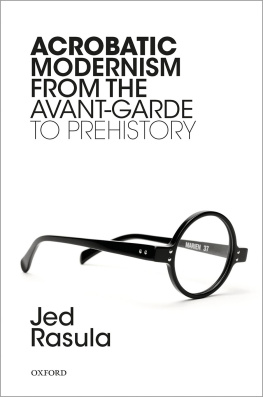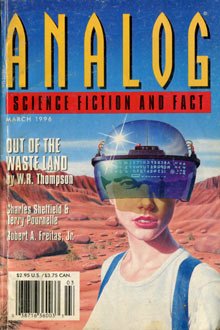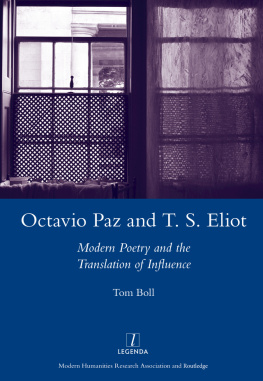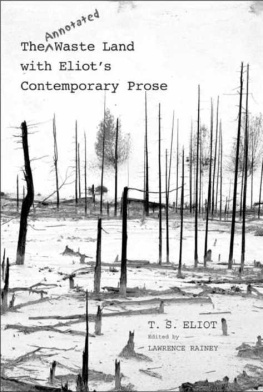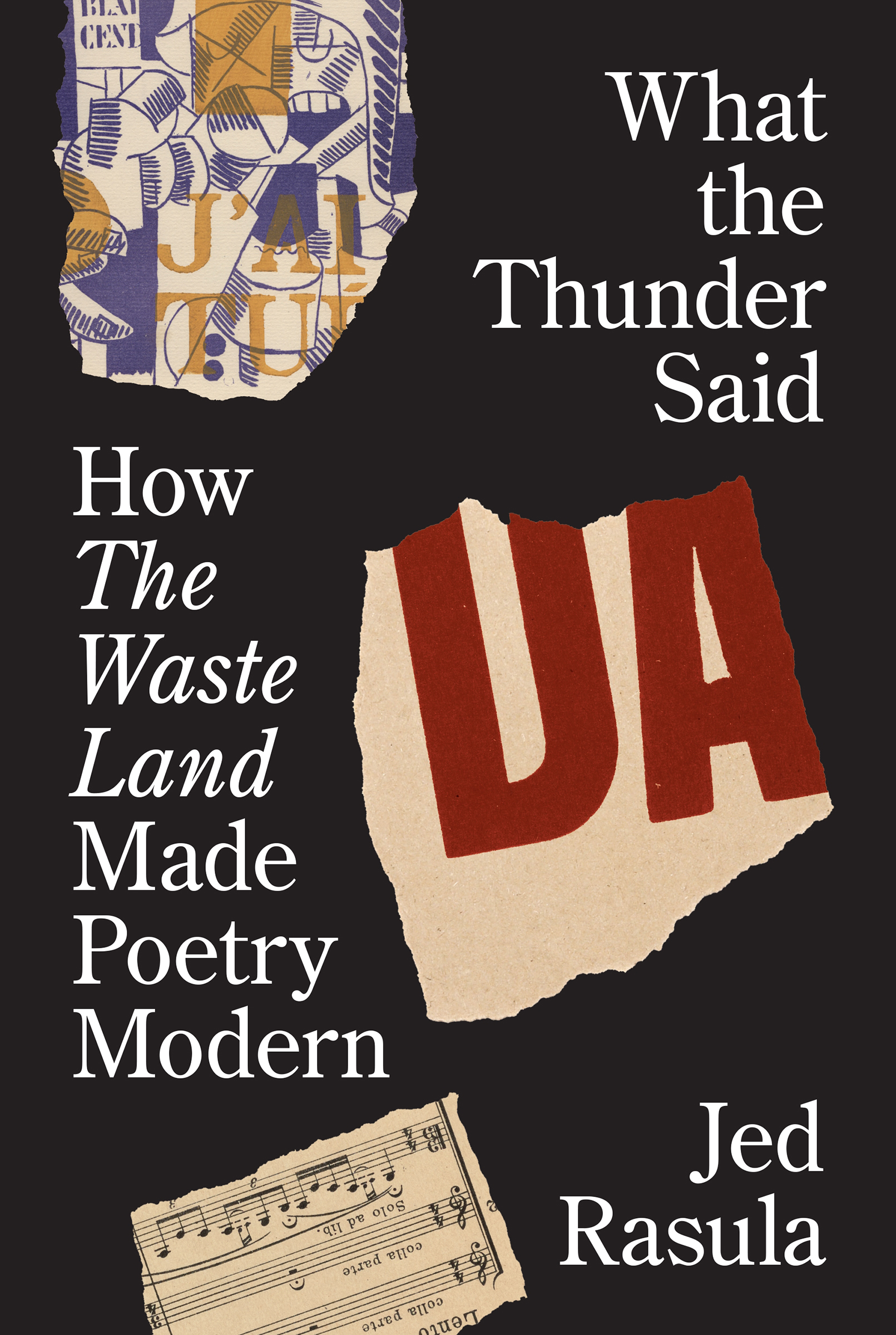WHAT THE THUNDER SAID
ALSO BY JED RASULA
Wreading: A Poetics of Awareness, or How Do We Know What We Know?
Genre and Extravagance in the Novel
Acrobatic Modernism from the Avant-Garde to Prehistory
History of a Shiver: The Sublime Impudence of Modernism
Destruction Was My Beatrice: Dada and the Unmaking of the Twentieth Century
Modernism and Poetic Inspiration: The Shadow Mouth
Syncopations: The Stress of Innovation in Contemporary American Poetry
This Compost: Ecological Imperatives in American Poetry
The American Poetry Wax Museum: Reality Effects 19401990
ANTHOLOGIES
Burning City: Poems of Metropolitan Modernity coedited with Tim Conley
Imagining Language: An Anthology coedited with Steve McCaffery
POETRY
Hectic Pigment
Hot Wax, or Psyches Drip
Tabula Rasula
WHAT THE THUNDER SAID
How The Waste Land Made Poetry Modern
JED RASULA
PRINCETON UNIVERSITY PRESS
PRINCETON & OXFORD
Copyright 2022 by Jed Rasula
Princeton University Press is committed to the protection of copyright and the intellectual property our authors entrust to us. Copyright promotes the progress and integrity of knowledge. Thank you for supporting free speech and the global exchange of ideas by purchasing an authorized edition of this book. If you wish to reproduce or distribute any part of it in any form, please obtain permission.
Requests for permission to reproduce material from this work should be sent to
Published by Princeton University Press
41 William Street, Princeton, New Jersey 08540
99 Banbury Road, Oxford OX2 6JX
press.princeton.edu
All Rights Reserved
shows cover artwork for The Waste Land by Martin Rowson, published by HarperCollins, 1990. Copyright Martin Rowson. Reproduced by permission of the author c/o Rodgers, Coleridge & White Ltd., 20 Powis Mews, London W11 1JN.
Library of Congress Cataloging-in-Publication Data
Names: Rasula, Jed, author.
Title: What the thunder said : how the Waste Land made poetry modern / Jed Rasula.
Description: Princeton : Princeton University Press, [2022] | Includes bibliographical references and index.
Identifiers: LCCN 2022006944 (print) | LCCN 2022006945 (ebook) | ISBN 9780691225777 (hardback) | ISBN 9780691225784 (ebook)
Subjects: LCSH: Eliot, T. S. (Thomas Stearns), 18881965. Waste land. | Eliot, T. S. (Thomas Stearns), 18881965Influence. | BISAC: LITERARY CRITICISM / Poetry | HISTORY / Modern / 20th Century / General | LCGFT: Literary criticism.
Classification: LCC PS3509.L43 W3785 2022 (print) | LCC PS3509.L43 (ebook) | DDC 821/.912dc23/eng/20220421
LC record available at https: / /lccn.loc.gov/2022006944
LC ebook record available at https: / /lccn.loc.gov/2022006945
Version 1.0
British Library Cataloging-in-Publication Data is available
Editorial: Anne Savarese and James Collier
Production Editorial: Lauren Lepow
Text and Jacket Design: Chris Ferrante
Production: Erin Suydam
Publicity: Jodi Price and Carmen Jimenez
Jacket images: (Top) Fernand Lger, detail of illustration from the cover of Blaise Cendrarss Jai tu, 1918 2022 Artists Rights Society (ARS), New York / ADAGP, Paris. (Middle) Wood type letters from Gothic No. 50 type specimen by Hamilton Manufacturing Co., courtesy of Tool Case. (Bottom) Detail of the introduction from the score for Le sacre du printemps by Igor Stravinsky, 1921, courtesy of The New York Public Library Digital Collections.
This book is for Suzi Wong,
who made the difference that made the book.
There is no substitute for a lifetime.
(Ezra Pound, Canto XCVIII)
CONTENTS
WHAT THE THUNDER SAID
INTRODUCTION
By the time T. S. Eliots poem The Waste Land entered public domain in the United States in 1998, it had been a staple of higher education for half a century. No teaching anthology could afford to omit it. Because Eliot succeeded in making the case that modern poetry had to be difficult, The Waste Land served as the paradigm of difficulty. More recently it has settled into its role as modernist icon, as every passing year brings a new round of centenaries commemorating modernism. Long canonized, Eliots poem has acquired the demeanor of a scenic viewpoint, with its park service plaque and swivel mounted telescope.
Eliots eminence as preeminent among poets (, as W. B. Yeats put it when he ascended to that role after Swinburne died in 1909) is not what it used to be. Yet because Eliot is no longer contemporary, his work is unencumbered by the reception accorded it on publication. And after a century of collage, of Dada and Surrealism, its disjunctive surface is less alarming. If it initially seemed a response to the late Great War, in its centennial year the poems themes of drought and drabness sound immediate and foreboding to a generation facing climate disaster and the moral bankruptcy of the political class. The poem, straddling past and future, applies pressure on the present.
The Waste Land has a double legacy. Its the milestone that vaulted its author to considerable fame and influence, culminating with the Nobel Prize in 1948. It has held a permanent place in the pantheon of modern poetry since its publication in 1922. It has been an intimidating lump in the syllabus for generations of undergraduates, and a chastening puzzle to graduate students. But The Waste Land is not only a poem; it names an event, like a tornado or an earthquake. Its publication was a watershed, marking a before and after. It was a poem unequivocal in its declaration that the ancient art of poetry had become modern.
Its time to take The Waste Land out of the classroom, out of the textbooks, to recover its force as explosive event, one that continues to emit an uncanny relevance a century later. In the centenary of its publication, The Waste Land merits recognition not as a poemtheres a mountain of scholarship on thatbut as a phenomenon. Eliots poem is a component in a broader cultural revolution that led to abstraction in art, atonality in music, and an overall flouting of conventions by the international avant-gardes. The Waste Land partakes of collage as compositional principle in the arts; and it shares with Marcel Duchamp and others the notion that modernism convened a space in which every artwork could be a conceptual gambit, a wager like a throw of the dice, but in a game for which theres no table, and no croupier.
From Arthur Rimbauds adamant exhortation in 1871 that one must be absolutely modern, to the international impact of The Waste Land half a century later, poetry was instrumental in making the modern an ism. But what was it about poetry prompting the thought that it needed to become modern? Was it something about modern life that seemed ripe for poetic treatment? And why poetry? Did poetry possess some symbolic currency unique among the arts? Or was it, rather, that modernist trends evident in other arts were felt to be lacking in poetry? Was it regressive? Did poetry need a makeover? And why did an art often associated with the adjective timeless feel the need to keep up with the times?
These are questions I asked myself a number of years ago and put to students in seminars. This book ruminates on the questions by tracing a line of poetry, spun out by Wagnerism and encompassing Symbolism, then given a differently ambitious torque as it was aligned with other arts in modernism. This is evident in the way


